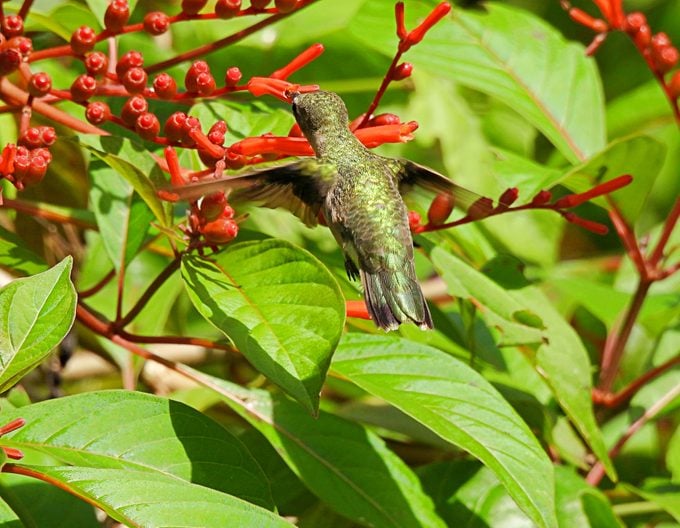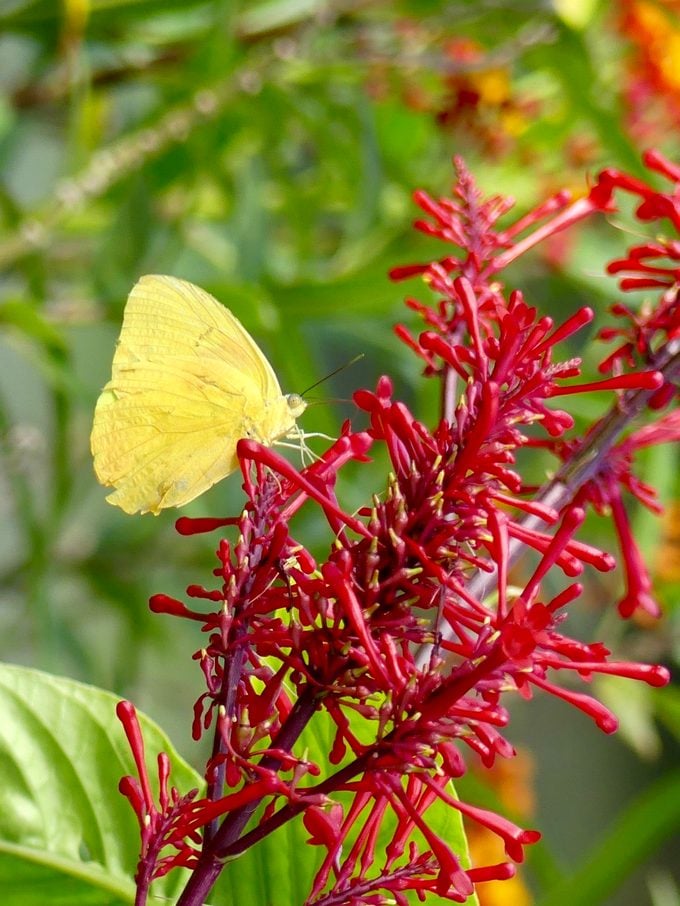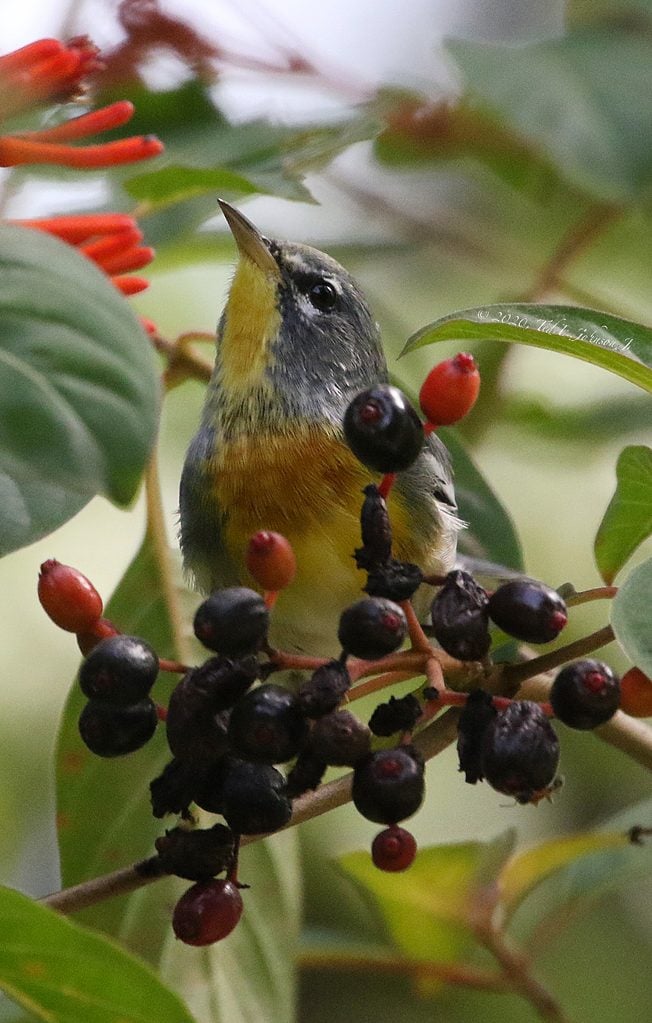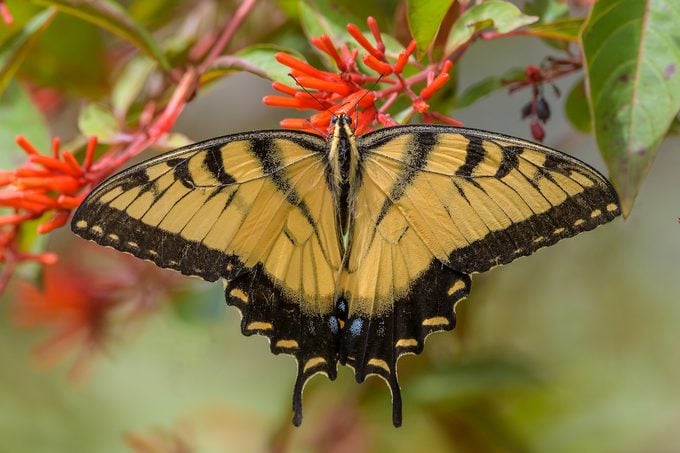Plant Native Firebush to Attract Hummingbirds
Updated: Feb. 27, 2023
Does firebush attract hummingbirds? The answer is a resounding yes!

If you’ve ever seen a firebush in bloom, no doubt you’ve noticed pollinators drawn to its brilliant red blooms. But does firebush attract hummingbirds? It does indeed! Though it’s native to the sub-tropics, you can grow firebush pretty much anywhere as an annual. Here’s how to help it thrive!
Check out the best perennials to grow for hummingbirds.
Firebush Fast Facts
- Latin name: Hamelia patens var. patens
- Other common names: Scarlet bush, Texas firebush, firecracker shrub
- Native range: Central to South Florida
- Growing zones: Annual to zone 8, perennial in zones 9 to 11
- Attracts: Hummingbirds, butterflies, bumblebees, songbirds
- Light: Full sun to part shade
- Size: Annual plantings grow to about 3 feet tall and wide in a season; perennial shrubs can reach 20 feet tall and 10 feet wide
- Flowers: Red trumpet-shaped flowers bloom year-round in zones 9 to 11; summer through first freeze in colder zones
- Foliage: Large lanceolate leaves, sometimes with a reddish tinge; leaves often turn red in fall or winter
Disover more nectar plants for hummingbirds you aren’t growing yet.
How to Grow Firebush

Firebush is an incredibly vigorous perennial in warmer climates (zones 9 to 11), where it grows and spreads quickly. It can withstand brief temperatures below freezing, though it may drop its leaves or even die back to the ground. Fortunately, it returns quickly when the temperatures rise, growing especially fast during the rainy season.
In colder climates, grow firebush as an annual or in pots to overwinter indoors. Water it regularly, and you’ll be rewarded with exuberant growth throughout the the spring and summer months.
Firebush isn’t too picky about the amount of sunlight it receives, tolerating full sun to part shade. It does require well-draining soil, similar to the sandy soil it enjoys in its native Florida. In areas with clay soils, amend the area with bark, manure, or compost to improve drainage before planting.
We found the top 10 hummingbird plants that grow in shade.
Does Firebush Attract Hummingbirds?
Anyone who loves hummingbirds knows that they usually seek out trumpet-shaped blooms. So it’s no surprise that hummingbirds love firebush! They’re often joined there by a variety of butterflies; zebra longwings (Heliconius charithonia) are regular visitors in their range. Pluto Sphinx moth caterpillars (Xylophanes pluto) even use it as a host plant. In the fall, the black berries attract songbirds and small mammals, who help spread the seeds.
Find out why butterflies and hummingbirds love tall verbena.
Is Firebush Invasive?

In zones 9 to 11, take care when purchasing firebush at your local nursery. The native Florida species (Hamelia patens var. patens), has broader leaves and narrow red flowers.
Non-native versions from Central America, including so-called “Dwarf Firebush” (H. patens var. glabra), have smaller leaves and yellow-orange flowers. These regularly escape cultivation and may contaminate the gene pool of the native Hamelia patens var. patens.
Before you go shopping, familiarize yourself with the differences between these types of firebush.
Still unsure whether you should plant firebush? Seek guidance from your local extension office.
Psst—hummingbirds can’t resist firecracker plant.
Firebush Care and Maintenance

Because of its fast growth habit, firebush grown in warmer zones may require regular pruning to keep it in check. It can be pruned at any time of year in these areas. Firebush grows readily from seed, so if unwanted spread is a concern, trim off the berries when they appear.
Growing firebush in pots in colder climates? Bring it indoors well before the first freeze, and keep the soil regularly moist throughout the winter. Return the pots to their outdoor locations when all danger of freezing weather has passed in spring.
In zone 9, firebush can be covered to protect the foliage if a freeze threatens. If the plant does die back to the ground, it will likely grow back from roots when warmer weather returns.
Next, find out how to grow a hummingbird mint plant.




















